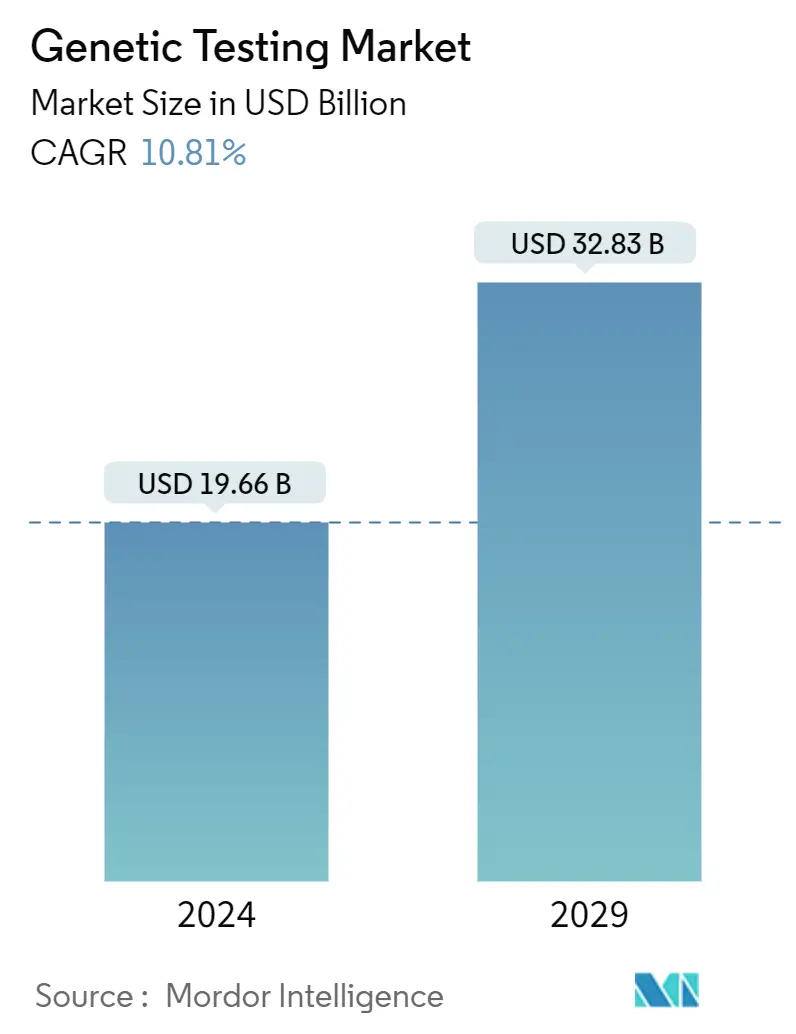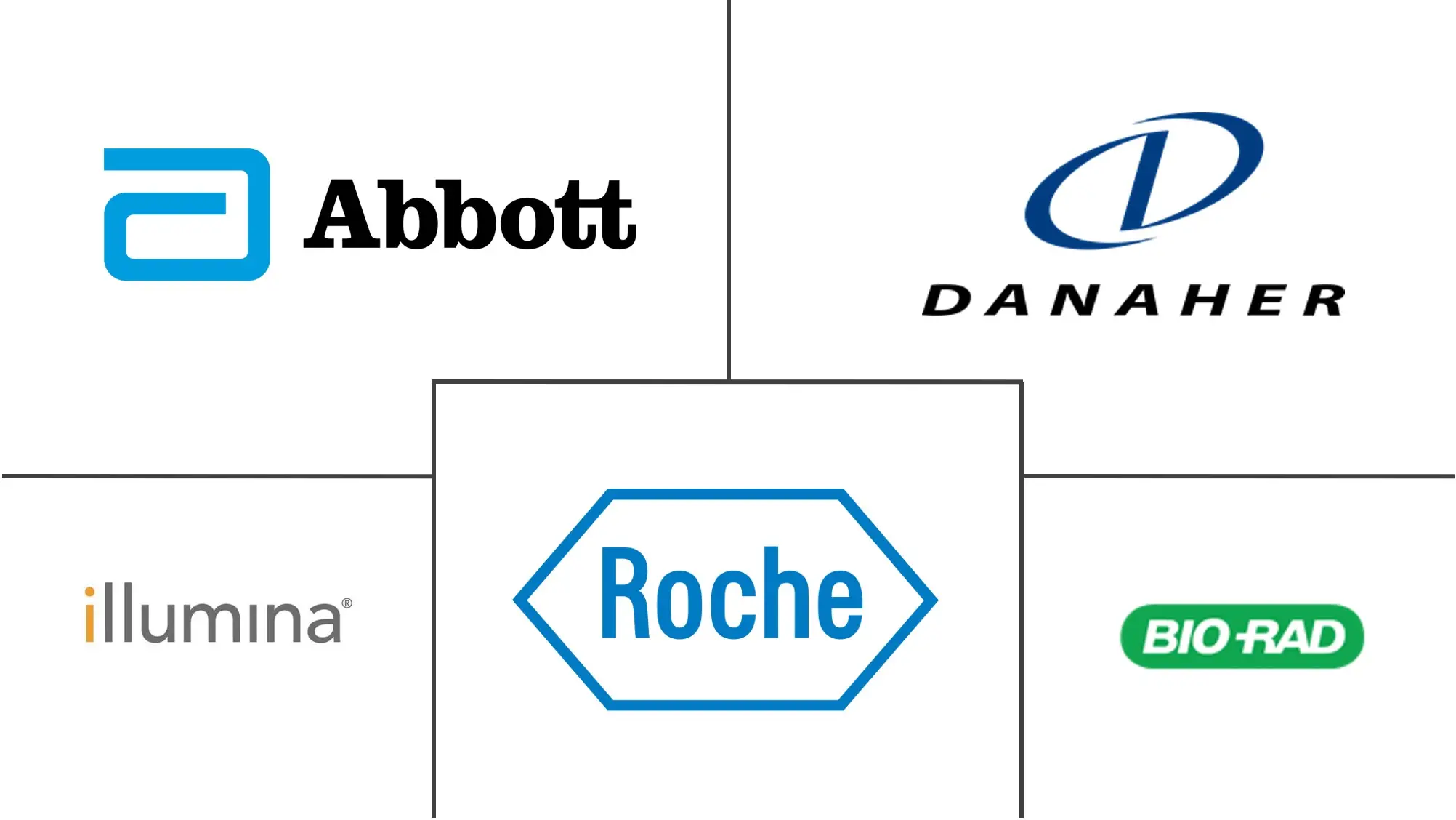Market Size of Genetic Testing Industry

| Study Period | 2019 - 2029 |
| Market Size (2024) | USD 19.66 Billion |
| Market Size (2029) | USD 32.83 Billion |
| CAGR (2024 - 2029) | 10.81 % |
| Fastest Growing Market | Asia-Pacific |
| Largest Market | North America |
| Market Concentration | High |
Major Players
*Disclaimer: Major Players sorted in no particular order |
Genetic Testing Market Analysis
The Genetic Testing Market size is estimated at USD 19.66 billion in 2024, and is expected to reach USD 32.83 billion by 2029, growing at a CAGR of 10.81% during the forecast period (2024-2029).
Genetic testing is a type of medical test that identifies changes in genes, chromosomes, or proteins. The results of a genetic test can confirm or rule out a suspected genetic condition or help determine a person’s chance of developing or passing on a genetic disorder. Factors such as the increasing prevalence of genetic disorders, rising investments in research and development of genetic testing, and increasing technological advancements are expected to drive market growth.
Genetic testing is used for the diagnosis of genetic disorders, such as cancer, cystic fibrosis, sickle cell anemia, and Alzheimer's disease. Early detection of these diseases using genetic testing procedures plays a pivotal role in managing these disorders. For instance, according to Alzheimer’s Disease Facts and Figures Annual Report 2023, more than 6 million Americans had Alzheimer’s disease. By 2050, this number is projected to rise to nearly 13 million. The increasing prevalence of these diseases increases the demand for genetic testing, which is expected to drive the market over the forecast period.
The rising investments in research and development of genetic testing procedures are also expected to drive the market. For instance, in November 2022, Redcliffe Labs invested USD 10 million in the development of genetics and specialized testing. In addition, in December 2022, the UK government, in partnership with the National Health Service (NHS), invested USD 175 million in genomics research to explore the effectiveness of using whole-genome sequencing testing to find and treat rare genetic diseases in newborn babies.
Increasing technological advancements and product launches over the past few years have opened several opportunities for market expansion. For instance, in June 2023, Devyser launched Devyser LynchFAP and Devyser BRCA PALB2. These two genetic testing kits are used to identify hereditary cancer syndromes. Hence, the increasing launch of such genetic testing products is expected to drive the genetic testing market. However, the social and ethical implications of genetic testing and the high cost of genetic testing are expected to restrain market growth.
Genetic Testing Industry Segmentation
A genetic test is a medical test performed to identify any changes in the DNA sequence or chromosome structure. The gene within the DNA sequence can be identified either directly through sequencing or indirectly through various genetic testing methods.
The genetic testing market is segmented by type, disease, technology, and geography. By type, the market is segmented into carrier testing, diagnostic testing, newborn screening, predictive and presymptomatic testing, prenatal testing, and other types. By disease, the market is segmented into Alzheimer's disease, cancer, cystic fibrosis, sickle cell anemia, Duchenne muscular dystrophy, thalassemia, Huntington's disease, rare diseases, and other diseases. By technology, the market is segmented into cytogenetic testing, biochemical testing, and molecular testing. By geography, the market is segmented into North America, Europe, Asia-Pacific, the Middle East and Africa, and South America. The report also covers the estimated market sizes and trends for 17 different countries across major regions globally. The report offers the values (USD) for all the above segments.
| By Type | |
| Carrier Testing | |
| Diagnostic Testing | |
| New-born Screening | |
| Predictive and Presymptomatic Testing | |
| Prenatal Testing | |
| Other Types |
| By Disease | |
| Alzheimer's Disease | |
| Cancer | |
| Cystic Fibrosis | |
| Sickle Cell Anemia | |
| Duchenne Muscular Dystrophy | |
| Thalassemia | |
| Huntington's Disease | |
| Rare Diseases | |
| Other Diseases |
| By Technology | |
| Cytogenetic Testing | |
| Biochemical Testing | |
| Molecular Testing |
| Geography | ||||||||
| ||||||||
| ||||||||
| ||||||||
| ||||||||
|
Genetic Testing Market Size Summary
The genetic testing market is poised for substantial growth, driven by technological advancements and an increasing focus on personalized medicine. The market, which experienced disruptions due to the COVID-19 pandemic, has rebounded to pre-pandemic demand levels and is expected to continue expanding. The rise in chronic diseases and the development of customized testing kits are key factors contributing to this growth. Governments worldwide are promoting awareness and regulation of genetic tests, facilitating their adoption. Major players in the market are investing in research and development, innovation in product design, and strategic partnerships to maintain a competitive edge. These efforts are exemplified by initiatives such as Avellino Labs' launch of the AvaGen genetic eye test and the FDA's approval of tests for genetic conditions like Fragile X Syndrome.
The cancer segment of the genetic testing market is particularly poised for significant growth, driven by the increasing incidence of cancer and heightened awareness of preventive diagnosis. Genetic tests play a crucial role in identifying hereditary cancer risks and informing treatment decisions for patients unresponsive to chemotherapy. Technological advancements and new product launches, such as Myriad Genetics' MyRisk Hereditary Cancer test, are expected to propel this segment further. North America currently leads the market, supported by a high demand for personalized genetic testing and a concentration of key players engaged in research and innovation. The competitive landscape is marked by strategic alliances and product advancements by major companies like Abbott Laboratories, BioRad Laboratories Inc., and Illumina Inc., which are enhancing market rivalry and driving growth.
Genetic Testing Market Size - Table of Contents
-
1. MARKET DYNAMICS
-
1.1 Market Overview
-
1.2 Market Drivers
-
1.2.1 Increasing Prevalence of Genetic Disorders
-
1.2.2 Rising Investments In Research And Development of Genetic Testing
-
-
1.3 Market Restraints
-
1.3.1 High Costs of Genetic Testing
-
1.3.2 Social and Ethical Implications of Genetic Testing
-
-
1.4 Porter's Five Forces Analysis
-
1.4.1 Threat of New Entrants
-
1.4.2 Bargaining Power of Buyers/Consumers
-
1.4.3 Bargaining Power of Suppliers
-
1.4.4 Threat of Substitute Products
-
1.4.5 Intensity of Competitive Rivalry
-
-
-
2. MARKET SEGMENTATION (Market Size by Value - USD)
-
2.1 By Type
-
2.1.1 Carrier Testing
-
2.1.2 Diagnostic Testing
-
2.1.3 New-born Screening
-
2.1.4 Predictive and Presymptomatic Testing
-
2.1.5 Prenatal Testing
-
2.1.6 Other Types
-
-
2.2 By Disease
-
2.2.1 Alzheimer's Disease
-
2.2.2 Cancer
-
2.2.3 Cystic Fibrosis
-
2.2.4 Sickle Cell Anemia
-
2.2.5 Duchenne Muscular Dystrophy
-
2.2.6 Thalassemia
-
2.2.7 Huntington's Disease
-
2.2.8 Rare Diseases
-
2.2.9 Other Diseases
-
-
2.3 By Technology
-
2.3.1 Cytogenetic Testing
-
2.3.2 Biochemical Testing
-
2.3.3 Molecular Testing
-
-
2.4 Geography
-
2.4.1 North America
-
2.4.1.1 United States
-
2.4.1.2 Canada
-
2.4.1.3 Mexico
-
-
2.4.2 Europe
-
2.4.2.1 Germany
-
2.4.2.2 United Kingdom
-
2.4.2.3 France
-
2.4.2.4 Italy
-
2.4.2.5 Spain
-
2.4.2.6 Rest of Europe
-
-
2.4.3 Asia-Pacific
-
2.4.3.1 China
-
2.4.3.2 Japan
-
2.4.3.3 India
-
2.4.3.4 Australia
-
2.4.3.5 South Korea
-
2.4.3.6 Rest of Asia-Pacific
-
-
2.4.4 Middle East and Africa
-
2.4.4.1 GCC
-
2.4.4.2 South Africa
-
2.4.4.3 Rest of Middle East and Africa
-
-
2.4.5 South America
-
2.4.5.1 Brazil
-
2.4.5.2 Argentina
-
2.4.5.3 Rest of South America
-
-
-
Genetic Testing Market Size FAQs
How big is the Genetic Testing Market?
The Genetic Testing Market size is expected to reach USD 19.66 billion in 2024 and grow at a CAGR of 10.81% to reach USD 32.83 billion by 2029.
What is the current Genetic Testing Market size?
In 2024, the Genetic Testing Market size is expected to reach USD 19.66 billion.

